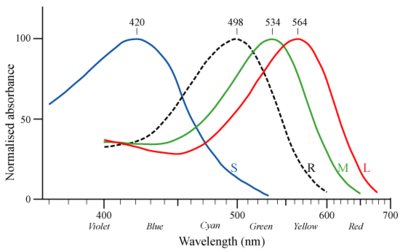Photopsin
|
|
Photopsins are the photoreceptor pigments found in the cone cells of the retina that are the basis of color vision. Photopsins are very close analogs of the visual purple rhodopsin that is used in dark vision. Photopsins consist of a protein called opsin and a bound chromophore, the retinal. Different opsins differ in a few amino acids and absorb light at different wavelengths as retinal-bound pigments. Opsins are G protein-coupled receptors. Isomerization of 11-cis-retinal into 11-trans-retinal by light induces a conformational change in the protein that activates the associated G protein and triggers a second messenger cascade.
In humans there are three different opsins that form the pigments photopsin I, II, and III. They are called porphyropsin, iodopsin and cyanopsin, respectively . These photopsins have absorption maxima for yellowish-green (photopsin I), green (photopsin II), and bluish-violet light (photopsin III). George Wald got the 1967 Nobel Prize in Physiology or Medicine for his experiments in the 1950s that showed the difference in absorbance by these photopsins (see image).
See also
- Rhodopsins, the pigment for monochromatic (scotopic) dark vision.
- Melanopsin, the pigment which is used to control pupil sizes and the sleep/wake cycle
External links
- Rhodopsin and the eye (http://www.chm.bris.ac.uk/webprojects2003/rogers/998/Rhoeye.htm), an excellent summary with pictures.
- Advanced Light And Vision Concepts (http://wolfstone.halloweenhost.com/TechBase/litadv_AdvancedLightingConcept.html), an extensive overview.

